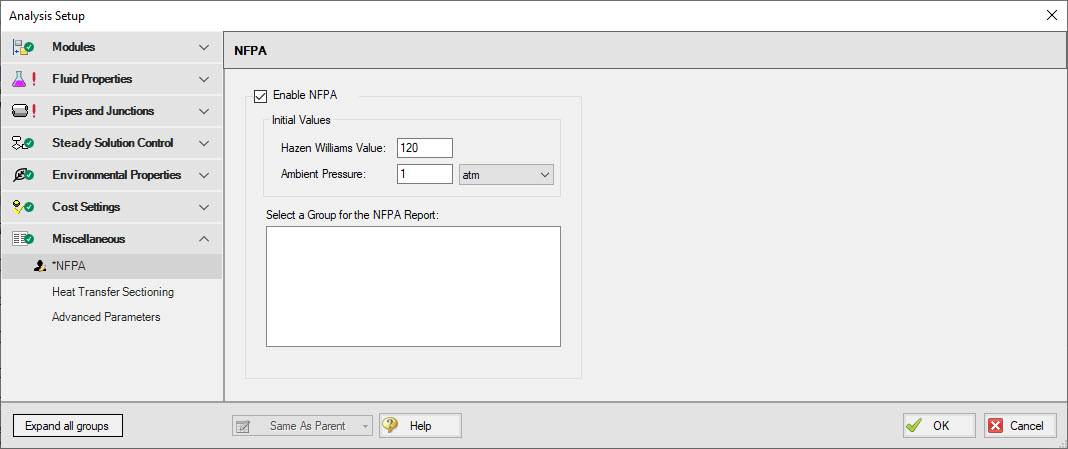NFPA Panel
The NFPA panel allows the user to enable NFPA settings, set the Hazen Williams factor, and define an ambient pressure for NFPA calculations.
NFPA stands for the National Fire Protection Association. This association develops codes and standards that are used by engineers designing safety related systems related to fire protection. AFT Fathom provides users the ability to specify remote paths and automatically calculate the hydraulics through that path as is recommended in NFPA 15 Section 8.5.3.1 (NFPA 15 (2012), pg 23NFPA 15, Standard for Water Spray Fixed Systems for Fire Protection, 2012 Edition.). When coupled with the GSC module (Goal Seek and Control), AFT Fathom includes the ability to determine the hydraulically most remote path automatically.

Figure 1: NFPA panel
NFPA Report
In order to generate the NFPA report, a group must be created using the Group Manger. This group must contain at least one spray discharge. It is best practice for this group to be a single continuous flow path connecting the most hydraulically remote spray discharge to the pressure source for the system. Once the group is created, a user will need to select the group on the NFPA panel above. Multiple groups can be created, but only one can be selected per run. To see how this is done, see the NFPA Firewater System Example. For more detail on NFPA reports consult the NFPA standard.
Terminology
The table below shows equivalent naming conventions between Fathom and the NFPA standard. Stagnation (total) pressure is equal to static (normal) pressure plus dynamic (velocity) pressure.
| AFT Fathom | NFPA Standard |
|---|---|
| Stagnation Pressure (Po) | Total Pressure (Pt) |
| Static Pressure (P) | Normal Pressure (Pn) |
| Dynamic Pressure | Velocity Pressure (Pv) |
Differences Between Fathom and NFPA Standards
The NFPA standard was built as a method that engineers could use to solve complex fire water networks via hand calculations. To accomplish this the NFPA standard uses certain assumptions which differ from the computational methods and precise solution methodology that Fathom uses in its Solver. Therefore, it is expected that Fathom and NFPA hand calculation results may differ. Some key differences are listed below:
-
Matrix Methods for Flow Splits - Fathom uses a matrix of equations to calculate the exact flow splits, whereas the NFPA Standard uses conservative estimates for flow splits.
-
Velocity Changes at Flow Splits - Fathom accounts for velocity changes at flow splits due to diameter changes and mass leaving the system at other nozzles.
-
Stagnation Pressure at Nozzle Exits - Fathom uses stagnation pressure as the driving force for flow out of all nozzles (inline and end nozzles), whereas the NFPA standard uses static pressure for inline nozzles (total pressure minus velocity pressure). Therefore, Fathom does not adhere to NFPA 15 (2012) Section A.8.5.1.2 (pg 48).



